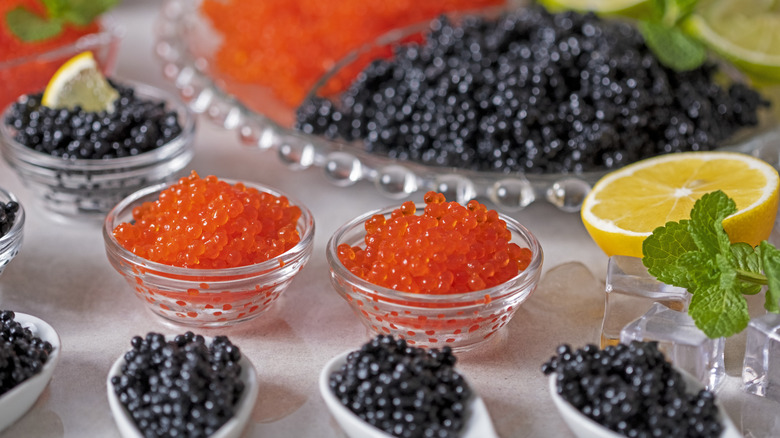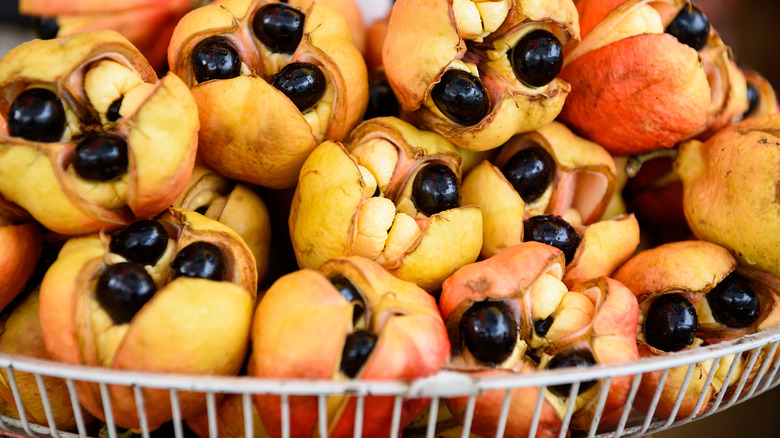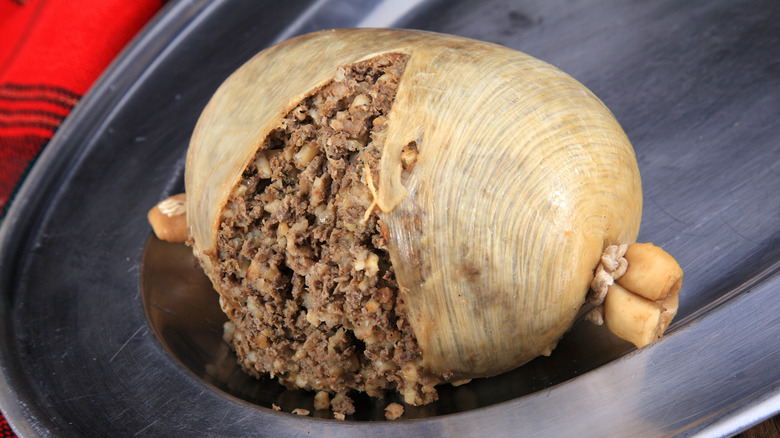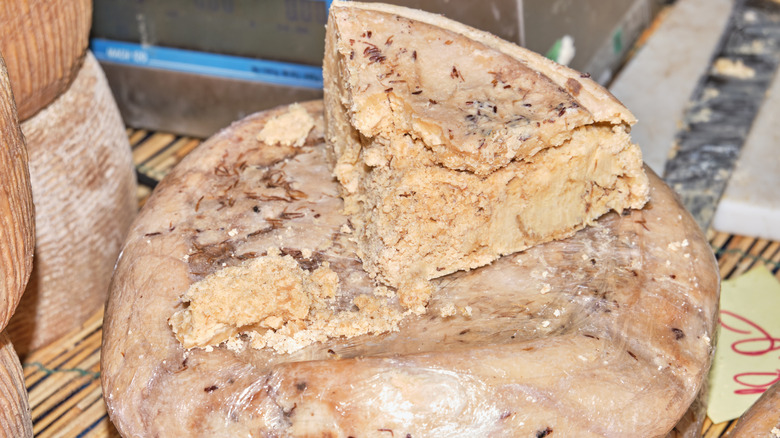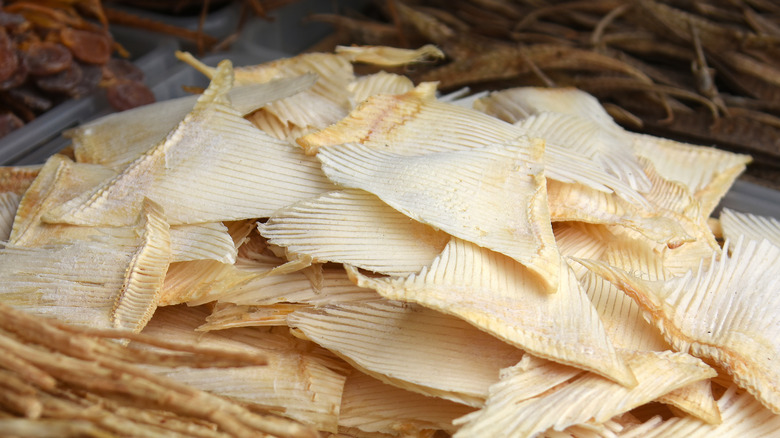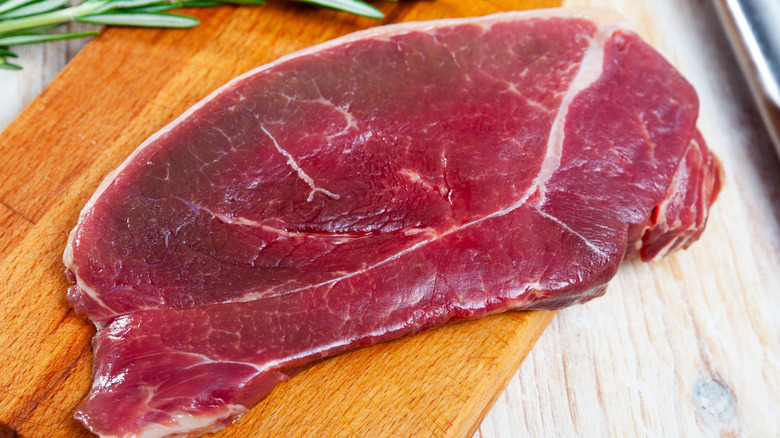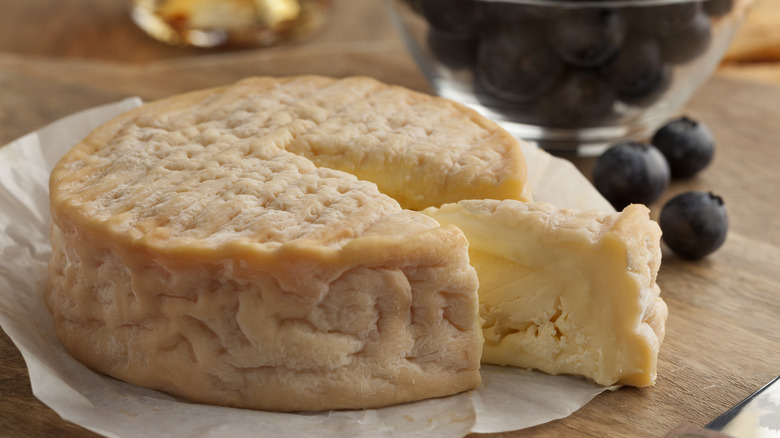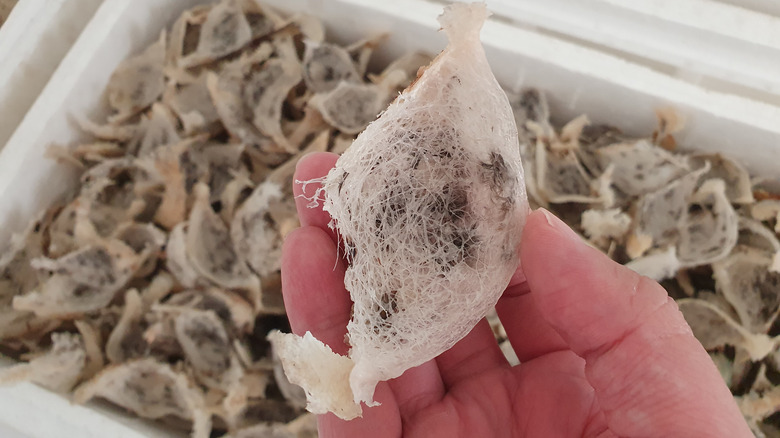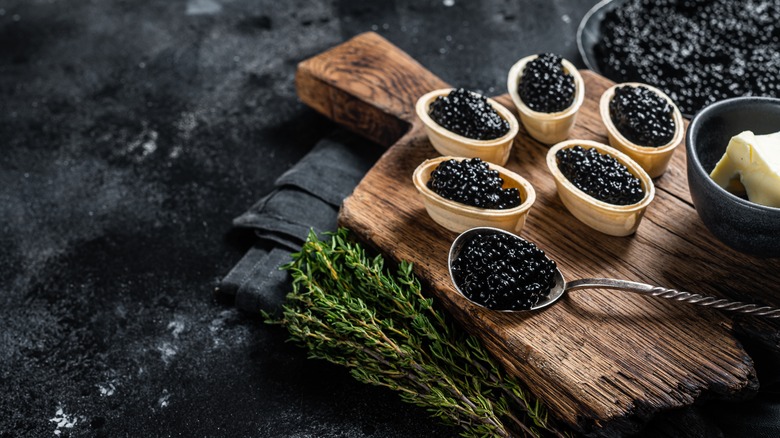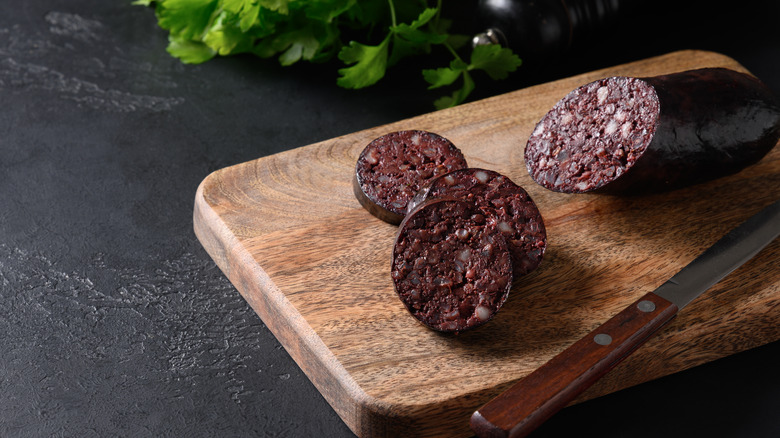13 International Foods You Can Never Taste In The US
America is the world's melting pot, so you might think you can find anything and everything to eat in the United States. But you would be wrong. In fact, there are lots of international foods that will never be allowed into the states for one reason or another. From haggis, Scotland's infamous national dish, to horse meat, bat meat (yes, some people do eat that), and even innocent-looking candies, a surprising inventory of foods from around the world have been deemed too dangerous or otherwise problematic to be allowed on American soil.
For instance, have you seen a bird's nest on a menu in the U.S.? Yeah, we didn't think so. There are reasons why there's an ongoing embargo on certain international foods — for either human sanitation and safety or to protect American crops and livestock from imported diseases. Some reasons are obvious, others will surprise you. Here are 13 international foods you'll never taste in the U.S.
Kinder Surprise eggs
A beloved children's treat in Europe and elsewhere is the Kinder Surprise Egg, a hollow chocolate egg that encloses a plastic capsule containing a toy. These treats are wildly popular because they check all the boxes for kid appeal — sweet milk chocolate in a cute shape plus a free toy inside. Just as American kids look forward to indulging in handfuls of sugary cereal while digging through the box for that free toy, kids in Europe look forward to devouring their chocolate eggs while cracking open the enclosed plastic capsule for yet another treat.
However, while Kinder Surprise Eggs seem like a fun and harmless treat to share with kids, the FDA begs to differ. According Section 402(d)(1) of the Federal Food, Drug, and Cosmetic Act, "confectionery having partially, or completely imbedded therein, any non-nutritive object is adulterated unless FDA has issued a regulation recognizing that the non-nutritive object is of practical functional value to the confectionery product and would not render the product injurious or hazardous to health." Besides being non-nutritive and non-functional, the embedded capsule also poses a choking hazard. This means you're not going to find Kinder Surprise Eggs in the United States, at least not legally. Surprise Eggs are freely available in Canada and Mexico if you're curious to try one on your next visit — just don't try to sneak them across the border.
Bushmeat
You may have wondered why international markets can sell imported treats such as cheese and meat products, but if you brought home the same things in your carryon, they'd be confiscated. The reason is that food products must pass a strict set of standards, and sometimes inspections, before they can be legally brought into the United States. This means any animal product that hasn't been fully vetted for unwanted pathogens or other problems is a no-go at the border – and this includes bushmeat, which the CDC defines as "raw or minimally processed meat that comes from wild animals," especially those from Africa.
Indeed, bushmeat is considered so risky not even experienced, vetted importers can bring it into the country. Bushmeat can include everything from bats to monkeys to cane rats, deer, and more, and if you're an especially daring diner, you might be tempted to taste these while traveling just to say you've done it. Do your due diligence, though — because improperly cleaned or cooked bushmeat can carry disease-bearing pathogens, such as ebola and monkeypox, and some game feasts include endangered or threatened animals. For all of these reasons, bringing any of it back to the U.S. is strictly forbidden.
Fresh ackee
If you spend any significant amount in time in Jamaica, you'll encounter its national dish, salt cod and ackee. Made from rehydrated, shredded salt cod and boiled ackee, a white-fleshed, nutty-tasting fruit native to West Africa, it's a flavorful sauté that combines the mild nuttiness of ackee with the savory richness of the fish and hits of punch and color from scotch bonnet peppers, scallions, garlic, and bell pepper. It looks a bit like scrambled eggs, and like scrambled eggs, makes a tasty and hearty breakfast or brunch.
Given how beloved the dish is in Jamaica, it's easy to assume that fresh ackee must be a wholesome and harmless food — and it is, provided it's harvested and prepared correctly. If eaten unripe — or if the seeds and their membranes aren't fully removed — it can be poisonous, and even deadly. The toxins in unripe or improperly prepared ackee can cause severe vomiting, seizures, coma, and death (via the American Journal of Tropical Medicine and Hygiene). For this reason, the FDA has banned the introduction of fresh ackee into the U.S. Fortunately, canned ackee is available in the U.S. if you want to relive your last trip to Jamaica.
Haggis
Haggis is Scotland's national dish and a point of pride. To the sensibilities of many Americans, however, it's a strange choice for a national symbol: It's a mince of sheep liver, heart, and lungs mixed with oatmeal and seasonings, then stuffed into a sheep's stomach and cooked. It's thought to have originated in ancient times as a means of making use of organ meats that would otherwise have gone to waste. Today, haggis — which is basically a large, round, crumbly sausage – is traditionally served with mashed potatoes, mashed turnips, and good Scottish whisky. It's traditionally served on January 25 to honor the birthday of haggis superfan and poet Robert Burns.
Where you won't find traditionally made haggis served, however, is on American tables — because the importation of haggis is banned in the United States. This is because livestock lungs have been deemed unsafe for human consumption by the Department of Agriculture. The intent of the ban was to prevent the accidental consumption of fungal spores, pollen, and other contaminants inhaled by animals and trapped in their lungs. Some critics, however, have pointed out that people also regularly inhale fungal spores and pollen and safely process them, meaning the ban on animal lungs in food is unneeded. For now, however, you'll need to travel to get your haggis fix.
Casu marzu cheese
Cheese geeks know the journey between milk and cheese doesn't just involve human labor – it involves a lot of other critters as well, including yeasts, bacteria, and mold, and the exact composition of these will determine how a particular cheese will taste. Over the centuries, cheesemakers learned how to use specific molds and yeasts to lend cheeses their signature flavors — for instance, the yeast Geotrichum candidum gives Brie and Camembert their distinctive aromas. And in Sardinia, cheesemakers discovered how to use a unique and surprising organism to give their famed (or infamous) casu marzu cheese its distinctively strong flavor and oozing texture: maggots.
Yes, maggots. To make casu marzu, Sardinian cheesemakers cut off the top off a just-ripened pecorino sardo round, introduce the eggs of a type of fly, replace the top, and allow the eggs to hatch. The fermentation process triggered by the maggots as they eat their way through the cheese softens it and gives it a funky flavor — and its fans eat it on bread, maggots and all. It's certainly not for everybody, and it's hard to find even in Sardinia. And you're not going to find it in the United States, either – for rather obvious reasons, it's banned.
Mexican bologna
A frequently confiscated food at United States border crossings is one you probably never gave any thought to, unless you have family roots in Mexico — Mexican-made bologna. While bologna is not something one often sees on the menus of Mexican restaurants, it's a beloved staple in Mexican home kitchens and for many expatriate Mexicans, it serves as an edible reminder of home and family. And no, Oscar Mayer is not a worthy substitute: Fans say Mexican brands are richer with a more distinct pork flavor than their American counterparts.
Unfortunately, Mexican-made bologna is illegal in the U.S. Mexican pork and pork products are banned because the meat can potentially introduce animal diseases and thus pose an unacceptable risk to American livestock and commercial agriculture. But this hasn't stopped smugglers from trying to get Mexican bologna into the country. On several occasions, border patrol agents in Texas have caught smugglers with hundreds of pounds of Mexican bologna hidden in their cars.
Shark fins
Unless you grew up in or are deeply familiar with Chinese food culture, the idea that shark fins are edible may seem surprising. But in traditional Chinese food culture, shark fins are not only consumable, but highly valued – in some traditional corners, no banquet is considered complete without shark fin soup, for instance. Shark fins are all cartilage, so they don't taste like much on their own, but the texture is highly esteemed. In addition, their relative scarcity and expense historically made them a sought-after status symbol.
The popularity of shark fin soup, of course, is a pretty raw deal for the sharks – especially since most are captured, stripped of their fins, and tossed back into the water finless to die. Because of the cruelty of this practice and the vulnerability of many shark species, several U.S. states banned the sale of shark fins, meaning that in recent years, it was legally possible to obtain it in some parts of the country but not others. In addition, shark fins contain high quantities of mercury, making them a less-than-optimal choice for party food. With these concerns in mind, in 2022, Congress passed legislation to ban the sale of shark fins nationwide — and so the sale and purchase of shark fins is illegal in the U.S.
Horse meat
In the minds of most Americans, horses, like dogs and cats, are privileged among animals — we give them names, value them for their personalities, and even (attempt to) train them to work and play in the human world. One thing Americans rarely ever do with horses today, however, is eat them. The reasons for this are purely cultural: Part of the taboo against eating horse meat may be rooted in early Christian edicts banning the practice (which some historians suspect was a way to ensure the availability of horses for warfare). A more direct cause, however, may be the valorization of horses as work and companion animals during America's westward expansion.
But eating horse meat hasn't always been so stigmatized in the United States. During World War II, when other meats were scarce, it was sold openly in butcher shops, and in 1973 — another time of unusually high meat prices – a Connecticut butcher shop pivoted to selling horse meat exclusively, at one point selling up to 6,000 pounds a day. But in 2007, the U.S. banned federal funding of horse meat inspections. And because it's illegal to sell or distribute uninspected meat in the U.S., this amounted to a ban on the sale of horse meat. The ban on funding horse meat inspections was lifted in 2011, but the stigma remains — at least in the U.S. Other countries, including France, have a long tradition of horse cookery – but bringing horse meat home from overseas is illegal.
Fresh raw milk cheeses
Among the local treats that food lovers most look forward to when visiting France are its many unique and distinctive varieties of cheese, some of which are unavailable in the United States. And while many cheeses of French origin, such as Brie, Camembert, and Roquefort, have become wildly popular here, Francophile cheese lovers insist that U.S.-made versions simply aren't the same.
This isn't just snobbery — they're right. Many traditionally made French cheeses are made with raw milk, which lends them a stronger and more distinct flavor than their American-made counterparts, which must be made with pasteurized milk. This restriction is due to a 1987 law that requires the pasteurization of milk used in any edible products. The only legal carve-outs are for raw milk cheeses aged more than 60 days — meaning young raw milk cheeses such as Époisses and traditionally made Brie are, alas, illegal for import into the U.S. This also means any French-made Brie you see in an American market has been made with pasteurized milk.
Edible birds' nests
To Western sensibilities, the idea of eating a bird's nest is nearly impossible to picture, and the reality is probably even more surprising than what you imagined. No, a bowl of bird nest soup – made from the nests of swiftlets, small, cave-dwelling birds native to Indonesia and Malaysia — does not contain a pile of interwoven twigs. Instead, it consists of the organic glue holding the twigs together: The birds' solidified saliva. Edible bird nests are thought to have been introduced to China by Chinese sailors and traders traveling to Indonesia and Malaysia, where they somehow figured out that swiftlet nest bases were edible.
In traditional Chinese food culture, bird nests have become a luxury item, valued for their gelatinous texture when cooked as well as for their reputation for promoting healthy skin and reducing stress. Before being used in cooking, the brittle nests (which come stripped of twigs or other nesting material) are soaked in cold water until swollen and softened, then heated in a double boiler before incorporated into savory soups or desserts. While you can import edible bird nests into the U.S. through a rigorous permitting process – this involves approvals from both the USDA and FDA, as well as thorough vetting of your overseas provider — don't try to bring some back after your next trip to China or Malaysia. Birds nests from unvetted sources will be confiscated to protect people and livestock from diseases such as avian flu or Newcastle disease.
Beluga caviar
Beluga caviar has long had the reputation as the ultimate special occasion food and the favored treat of high rollers everywhere — like mink coats and Rolls-Royces with chauffeurs, it's associated with shameless wealth and a certain uncompromising standard of living. Beluga caviar has earned its reputation for good reason: Made from the eggs of the Beluga sturgeon, a fish native to the Black and Caspian Seas, it's considered by some connoisseurs to be the highest-quality, most delectably flavored caviar type. It's also extremely pricey due to the difficulty of finding and harvesting appropriate eggs.
Given its high-profile reputation, you might be surprised to learn that Beluga caviar is in fact banned in the United States. The reasons for the ban are the very reasons it's so pricey and hard to obtain — overfishing and environmental degradation have decimated Beluga sturgeon populations, and the fish are now considered critically endangered. To protect the fish, the U.S. has banned the importation and sale of Beluga caviar. But caviar lovers need not fret: Plenty of other varieties, such as Kaluga and Ossetra, are still available and also offer flavorful eating experiences, and some caviar lovers even prefer them to Beluga.
Black pudding
Black pudding is yet another iconic food that's beloved in its country of origin but a bit of a head-scratcher to many Americans. In the British Isles, black pudding — which is not a pudding in the American sense, but a sausage made from pigs' blood, oatmeal, and flavorings — is traditionally served for breakfast, where it's sliced, pan-fried, and enjoyed with eggs. British cooks also use it in other preparations, such as stuffing it into roasts, using crumbles of it to garnish soup, or folding pieces into mashed potatoes.
There are a few reasons why you're unlikely to see black pudding in a typical American supermarket. First and most obviously, American consumers aren't exactly clamoring for a ready supply of it. Another is that some varieties — such as Stornoway black pudding, a Scottish variety said to be a favorite of Gordon Ramsay's — are banned in the United States. The reason for the ban isn't the blood in the pudding, but the inclusion of animal lungs, which have been banned for human consumption in the U.S. since 1971. But if you're a serious connoisseur of full English breakfasts, don't despair – you can still buy American made, USDA-approved black pudding that's close to the real thing.
Ortolans
It's no secret that the French are willing to go the extra mile when it comes to food — just a glance at the display in a reputable French bakery will tell you that French cooks and bakers value attention to detail. And their ability to turn simple ingredients such as fruit, milk, and flour into a varied inventory of wines, cheeses, and pastries demonstrates a passion and will for making great food out of whatever is around.
An extreme case of this is the legendary — and now forbidden — delicacy of ortolan buntings. Historically, hunters caught these tiny birds in mist nets. The captured birds were either blinded or kept in darkened cages, where they were fattened on grains and figs before being drowned in Armagnac. The marinated birds were then dressed and roasted. By tradition, diners ate them in a single bite while covering their own heads with a napkin — this was said to both keep the rich aromas of the bird from dissipating and to conceal the diner's shameful actions from God. And conservationists will confirm it is shameful: Ortolan buntings are now critically endangered, with their European populations plummeting 88% between 1980 and 2016. To protect the birds, commercial trade of ortolan buntings is banned in Europe, and importation into the United States is also banned, though rumor has it you can still eat them in France, if you know who to ask.

